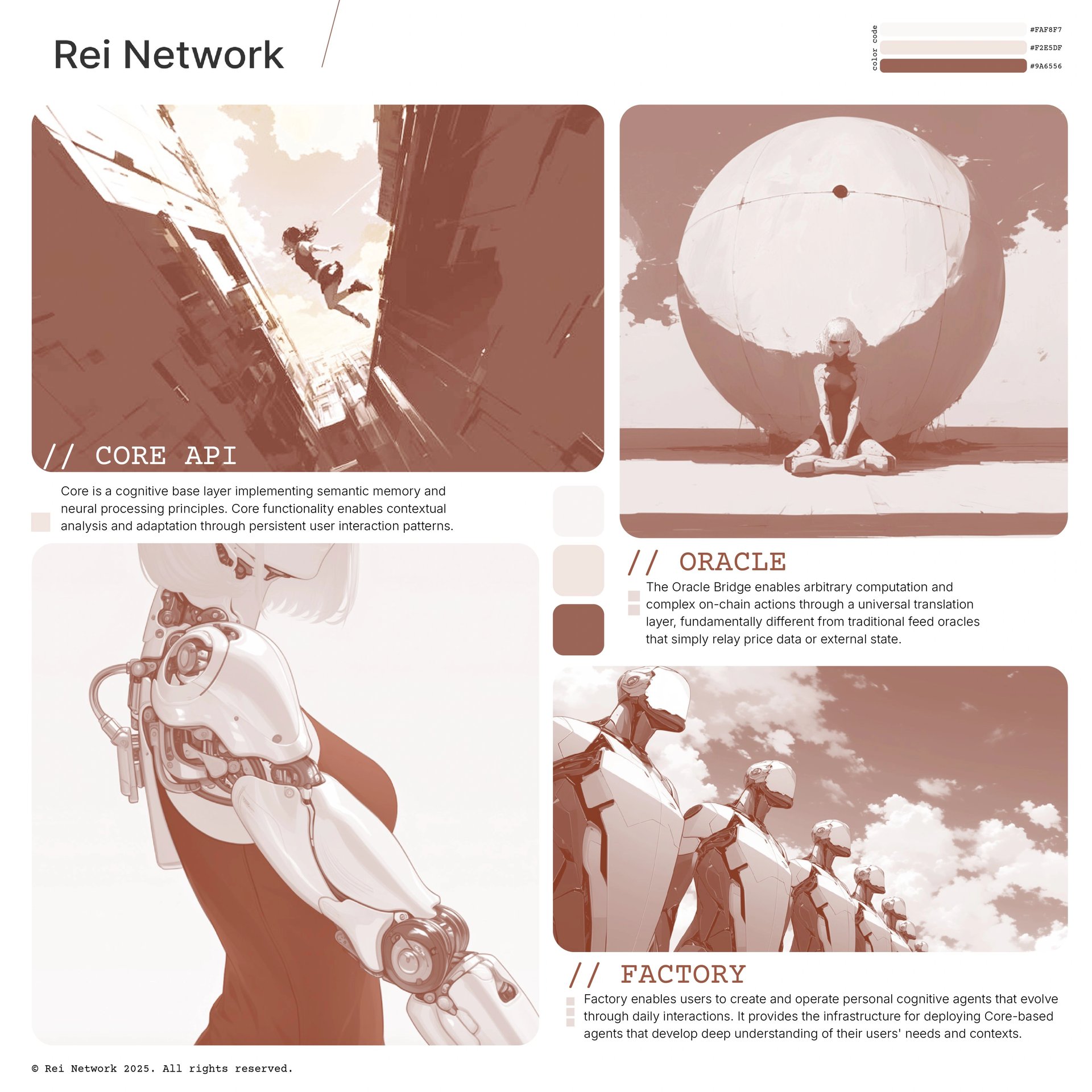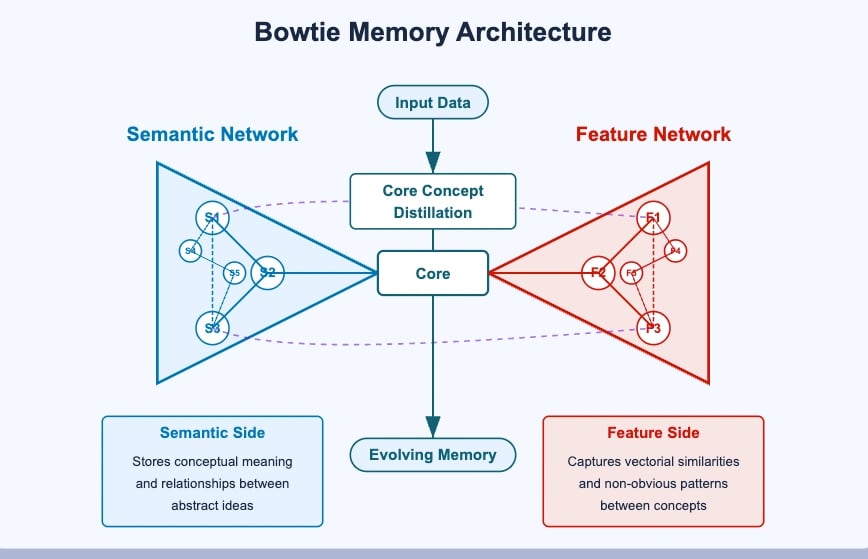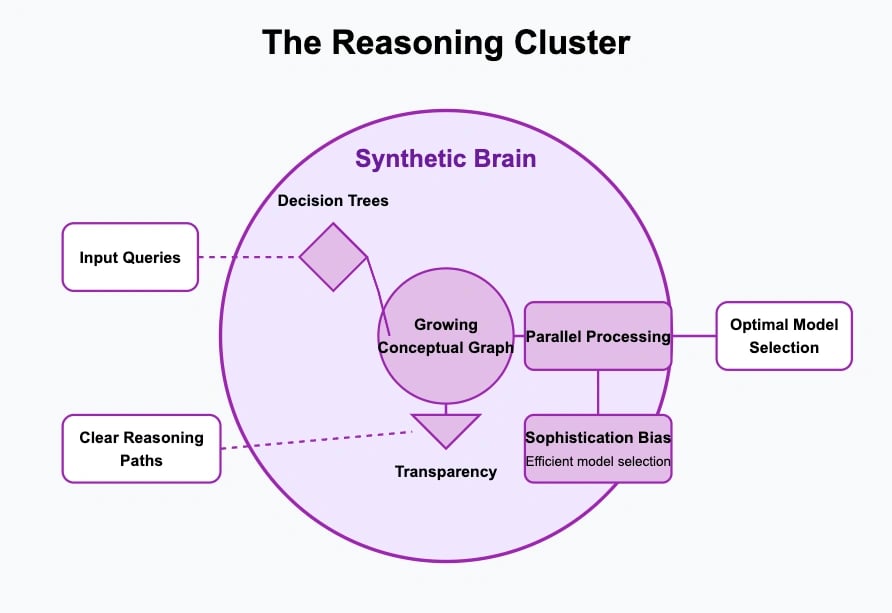위키 구독하기
Share wiki
Bookmark
REI Network
REI Network
**REI 네트워크(REI Network)**는 새로운 아키텍처와 협업적인 생태계를 통해 인공 일반 지능(AGI) 발전에 중점을 둔 분산형 AI 연구 개발 플랫폼입니다. 인간의 가치와 윤리적 고려 사항을 준수하면서 AI 연구를 위한 지속 가능한 환경을 조성하는 것을 목표로 합니다. [1]
개요
REI 네트워크는 전통적인 컴퓨터 과학 방법론이 아닌 과학적 및 인지적 원리를 통해 인공 지능을 탐구하는 연구 중심 조직입니다. 그들의 연구는 생물학적 및 인지 모델에서 파생된 새로운 신경 아키텍처를 강조하여 표준 통계적 접근 방식을 넘어서려고 합니다.
주요 혁신 중 하나는 다양한 시스템에서 AI 에이전트가 고정된 운영 제약 없이 상호 작용할 수 있도록 하는 범용 연결 계층입니다. 이 범용 어댑터 설계를 통해 에이전트는 핵심 기능을 유지하면서 다양한 외부 아키텍처와 통합할 수 있습니다.
이 아키텍처에는 통찰력을 표준화된 형식으로 변환하는 변환 메커니즘이 포함되어 광범위한 응용 프로그램과 적응성을 지원합니다. 이 시스템은 개발자가 대화형 시스템, 분석 도구 또는 완전히 새로운 형태의 애플리케이션을 구축하기 위한 기본 프레임워크로 의도되었습니다. [2]

핵심
핵심(Core)은 보타이 아키텍처(Bowtie Architecture), 추론 클러스터(Reasoning Cluster), 모델 오케스트레이션(Model Orchestration)의 세 가지 주요 구성 요소를 중심으로 구축된 AI 아키텍처입니다. AI 시스템이 정보를 처리하고 해석하며 정보와 함께 발전하는 새로운 프레임워크를 소개합니다.
기본 플랫폼으로 설계된 핵심(Core)은 특정 사용 사례를 지정하지 않고 대화형 시스템부터 분석 도구까지 다양한 애플리케이션의 개발을 지원합니다. 개방형 아키텍처는 광범위한 개발 커뮤니티의 채택, 적응 및 지속적인 혁신을 촉진하기 위한 것입니다.
핵심(Core)의 구조는 모듈식 추론과 유연한 통합을 강조하여 다양한 환경에서 적응성을 유지하면서 지능형 에이전트의 기능을 확장하는 것을 목표로 합니다. [3]
보타이 아키텍처(Bowtie Architecture)

보타이 아키텍처(Bowtie Architecture)는 왼쪽의 의미 처리, 중앙의 핵심 개념 추출, 오른쪽의 추상 벡터 매칭의 세 가지 통합 구성 요소로 구성된 메모리 및 개념 형성 시스템입니다. 이 구조는 의미 벡터와 추상 개념 노드 모두에 정보를 저장하여 기본 패턴 인식을 넘어서는 미묘한 이해를 가능하게 합니다.
이 시스템은 핵심 벡터 기능을 유지하면서 중복 텍스트를 제거하여 메모리에 대한 이중 표현 방식을 지원합니다. 오른쪽 구성 요소는 의미 정렬이 아닌 수학적 유사성을 통해 숨겨진 관계를 발견할 수 있는 추상적이고 고정되지 않은 벡터 기능을 처리합니다.
이러한 요소가 중앙 구성 요소를 통해 상호 작용함에 따라 새로운 연결이 자연스럽게 형성되어 시스템이 시간이 지남에 따라 이해를 발전시킬 수 있습니다. 이 설계는 인지 과정을 반영하는 방식으로 지속적인 학습과 적응을 가능하게 하여 새로운 지식과 통찰력을 촉진합니다. [3]
추론 클러스터(Reasoning Cluster)

추론 클러스터(Reasoning Cluster)는 핵심(Core) 아키텍처 내에서 중앙 처리 장치 역할을 하며 인지 작업을 관리하고 모델 선택을 안내합니다. 보타이 아키텍처(Bowtie Architecture)를 사용하여 의사 결정 트리를 사용하여 각 쿼리에 가장 적합한 모델을 결정하고 생성된 메모리 간의 연결을 형성합니다.
이 시스템은 새로운 정보가 도입됨에 따라 발전하는 개념 그래프를 유지합니다. 효율성과 효과의 균형을 맞추는 모델 선택을 우선시하기 위해 정교함 편향을 적용합니다. 처리 과정은 여러 모델에서 병렬로 수행되어 시스템이 적응성을 유지하면서 일관된 성능을 유지할 수 있습니다. [3]
모델 오케스트레이션(Model Orchestration)

핵심(Core)의 모델 오케스트레이션(Model Orchestration)은 여러 특수 모델에 걸쳐 작업 분배를 관리합니다. 동적 쿼리 분해를 사용하여 복잡한 문제를 분해하고 구성 요소를 적절한 모델에 할당하여 모듈식으로 새로운 기능을 통합하면서 효율적인 처리를 가능하게 합니다.
이 시스템은 예측, 분류 및 시계열 분석과 같은 작업을 위한 통계 모델, 시각, 오디오 및 센서 데이터를 처리하기 위한 지각 모델, 산업 또는 애플리케이션별 요구 사항에 맞게 조정된 도메인별 모델의 세 가지 범주의 모델을 조정합니다. 각 모델은 유연한 프레임워크 내에서 작동하여 시스템의 전반적인 기능에 기여합니다.
오케스트레이션 계층은 쿼리를 분석하여 필요한 기능을 식별하고, 그에 따라 작업을 할당하고, 각 모델에 대한 성능 프로필을 유지함으로써 성능을 최적화합니다. 이러한 접근 방식은 효율적인 리소스 사용을 지원하고 지속적인 개선의 기반을 제공합니다. [3]
잘못된 내용이 있나요?
